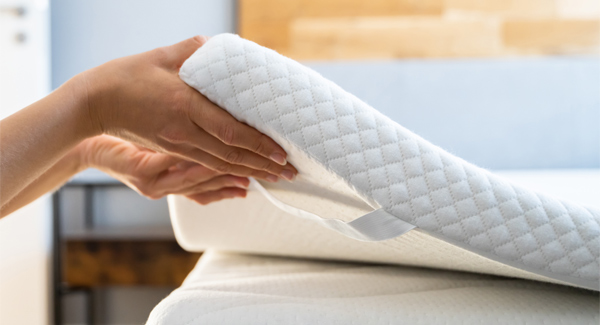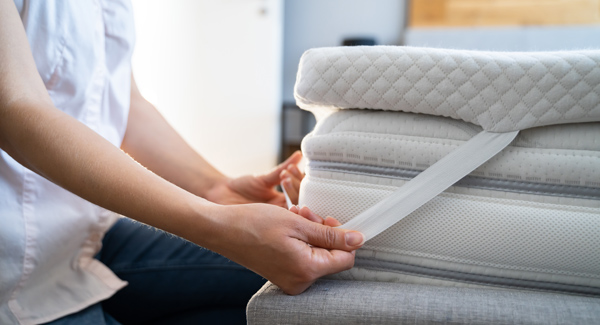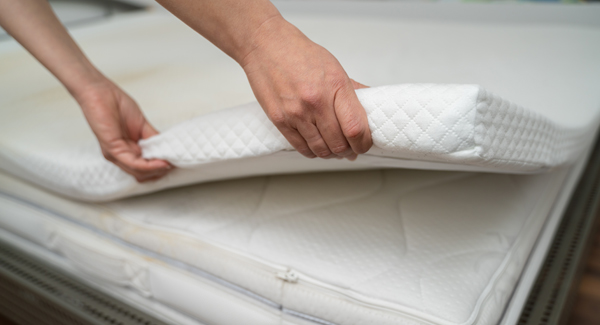Home » Bedding advice » How Long Do Mattress Toppers Last?
How long do mattress toppers last?
Article navigation
- Published:
- Written by: Tony Brown
- Topic: Bedding advice
A mattress topper is an extra layer of padding that sits on top of your mattress to make it feel more comfortable. Mattress toppers come in various thicknesses and materials, including memory foam, latex, wool, and polyester.
The typical lifespan of a mattress topper is between 2 and 5 years. Some mattress toppers may last longer, while others may wear out sooner. Material quality, construction, usage, and how well the topper is maintained influence its lifespan.

How long do polyester mattress toppers last?
A polyester mattress topper usually lasts around 2 years. Synthetic mattress toppers, like those made from polyester, are less durable than natural materials such as wool and latex. They compress faster, resulting in reduced loft and comfort over time.
Synthetic materials are less breathable, which can create a damp and uncomfortable sleep environment. They also retain bad odours and typically need laundering and replacing more frequently.
How long do memory foam toppers last?
Memory foam is a popular material that gently moulds and cushions the body. It is renowned for its excellent pressure relieving capabilities.
Typically, a memory foam mattress topper can last about 3 to 4 years. However, higher-density memory foam retains its shape longer and is less prone to sagging and body impressions.
How long do latex toppers last?
Latex is a resilient material that conforms well to body shape. Like memory foam, latex offers good support and pressure relief from sensitive areas like the shoulders and hips. A latex mattress topper can be made from natural or synthetic latex.
Natural latex typically lasts longer than other toppers, often up to 5 years or more. It is a durable material that retains its shape well over time.
How long do feather toppers last?
Feather mattress toppers, filled with loose feathers, offer a soft, plush feel. They typically last between 2 to 5 years. To maintain their comfort and loft, it is important to fluff and shake the topper regularly. This helps redistribute the feathers and prevent clumping.
How long do wool toppers last?
Wool is known for its strength and durability. It is naturally resilient and can withstand heavy wear and tear.
With proper care, a wool mattress topper can last 5 years or more. Its natural elasticity allows it to maintain its shape and comfort over time, making it ideal for those looking for a mattress topper that will stand the test of time.
Wool’s breathability and moisture-wicking properties make it suitable for both summer and winter, ensuring a comfortable year-round sleep experience.
What factors affect the lifespan of a mattress topper?
Several factors affect the lifespan of a mattress topper, such as material quality, construction, usage and how well it is maintained and looked after.
Material quality
The materials used in a mattress topper can significantly impact its longevity. Higher-quality materials like latex, wool and cotton tend to last much longer than synthetic materials like polyester.
Construction
The quality of construction can also affect the lifespan of a mattress topper. Toppers made to the highest standards and meticulous attention to detail typically outlast those mass-produced inexpensively.
High-quality toppers typically feature durable stitching, reinforced seams, and high-quality materials. These toppers are designed to withstand daily wear and tear and maintain their shape and support over time.
On the other hand, cheaper mattress toppers may be prone to premature sagging, flattening, or deterioration.
Thickness
Mattress toppers range from 1 to 4 inches in depth. Thicker toppers generally last longer because their extra padding better conforms to the body. They can often withstand daily wear and tear and maintain their support and comfort for longer. In contrast, thinner toppers tend to wear out faster and are more likely to bottom out. However, the overall durability also depends on the quality of the materials and construction.
Usage
How the mattress topper is used can affect its lifespan. Toppers used daily, for example, will wear out much sooner than those used occasionally, for instance, in a guest room.
Your body weight can also influence the topper’s longevity. For example, a topper used by a heavier person may sag and deteriorate more quickly because more pressure is applied to the components.
It also depends on the firmness of the mattress you use with your topper. An overly firm mattress offers little give, leaving the topper to do most of the work. As a result, the mattress topper may wear out sooner than expected.
Furthermore, A mattress topper used by two people will likely wear out faster than one used by a single person.
Care and maintenance
Following the manufacturer’s care instructions and advice can help extend the life of the mattress topper. This includes regular cleaning, using a mattress protector to keep the sleeping surface clean and occasionally turning the topper where necessary to help even out the wear.
Signs you need to replace your mattress topper
If you’re not sleeping well, your mattress topper could be causing the problem. Several signs might indicate your mattress topper needs replacing.
Wear and tear
Over time, your mattress topper may become lumpy and sag. An uneven sleeping surface can put the body out of alignment and indicate that your topper can no longer provide adequate support.
If you place a mattress topper on an old, worn-out mattress, it will simply take the mattress’s shape and dip in the same areas. Therefore, you should also inspect the mattress for wear and tear. Turning the mattress might help to even out some of the wear, but if the fillings don’t recover, you should replace your mattress.
Also, look for other signs of wear and tear, such as discolouration, stains, rips, tears and holes.
Discomfort
An uncomfortable mattress topper can leave you feeling tired, groggy, sore and achy in the morning. If you feel worse when you wake up than when you went to bed, this could indicate your mattress topper needs replacing.
Lack of support
If your mattress topper feels different from when you first bought it, it may be a sign that it needs replacing. Changes in your body weight, having a new sleeping partner, or general deterioration of the topper could be why it is not supporting you correctly.
Your allergies have worsened
Over time, your topper accumulates sweat, dead skin, body oils, and other substances. This creates the perfect conditions for dust mites, bacteria and mould. If your allergies are worse at night, for example, you find it difficult to breathe, or cough or sneeze more than usual, this could be due to your topper.
Lingering odours
An old mattress topper might develop an unpleasant smell from the accumulation of sweat, body oils and spillages. Regular cleaning can help eliminate these odours. However, if the smell persists, replacing your topper is advisable for hygiene reasons.
Partner disturbance
If you or your partner disturbs each other more in bed than usual, it could be a sign that the topper is failing to absorb movement effectively.
How to extend the life of a mattress topper
Taking care of your mattress topper can help maintain its condition, extend its life and ensure it remains comfortable and supportive.
Use a mattress protector
A good-quality mattress protector protects your topper from stains, spillages, sweat and dirt. It will help keep the sleeping surface clean, dry, hygienic and in good condition. A mattress protector also provides an effective barrier against dust mites.
Turn your mattress topper
Occasionally turning your mattress topper can help even out the wear. How and when you turn your topper depends on the manufacturer’s recommendations. Some toppers only require rotating, while others can be flipped.
Regular cleaning
Regularly cleaning your bedding, including your mattress topper helps maintain a clean and comfortable sleep environment.
Follow the manufacturer’s cleaning recommendations for your topper. While some may be machine washable, others require dry cleaning. Clean your mattress topper immediately after spillages to prevent liquids from seeping into the topper and causing unpleasant odours, stains, or potential mould and mildew growth. Immediate cleaning helps keep the sleeping surface hygienic and in good condition.
Storing your mattress topper
When not in use, store your mattress topper in a cool, dry place to prevent mould and mildew from developing. Roll your mattress topper instead of folding it to prevent damage.
Final thoughts
A mattress topper can improve the comfort of a relatively new mattress and typically lasts between 2 to 5 years. Its lifespan can be extended through regular cleaning, turning, and using a mattress protector.
However, a mattress topper should not be considered a cheap alternative to purchasing a new mattress. A mattress topper is unlikely to make much difference if your mattress is worn out. It will conform to the mattress’s shape and dip in the same areas.
Share this article

About the author
Tony Brown is the founder and creator of The Bed Consultant. His career in the bed industry began in 2002. After graduating from university with a degree in Business Administration, Tony joined one of the largest independent furniture retailers in the UK as a bed consultant. Tony has helped thousands of customers find the perfect mattress.


